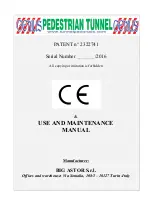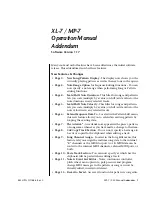
123
New Brunswick Scientific
User’s Guide
21.3
What is Probe Calibration
?
In bioprocess control,
calibration
generally refers to establishing a correspondence
between a probe’s output and the actual value of whatever that probe senses. For
example, pH probes are often calibrated with pH 7.0 and pH 4.0 buffers to establish a
“zero” (pH 7.0) and a “span” (pH 4.0). Other buffers can be used, but the principle is
always the same. For any probe calibration, two values—a zero and a span—are
required for the controller to correctly translate inputs from that probe. DO and pH
probes are routinely calibrated before each use. Most other probes need be calibrated
only infrequently.
21.4
What are P-I-D Constants?
The mathematics of
P-I-D
control is familiar to most control and process engineers.
In
P-I-D
mode, the controller creates a control signal that is based upon setpoint and
input from a sensor. The magnitude of the control signal is determined by a
mathematical formula that can include proportional (“P”), integral (“I”) and derivative
(“D”) terms. The
P
,
I
and
D
constants are three numbers that determine the relative
sizes of the proportional, integral and derivative terms, respectively. To use a
temporal analogy, the
P
or proportional part of the control signal reflects present
deviations between setpoint and current value. The
I
or integral component reflects
past deviations, and the
D
or derivative term anticipates future values of the error.
Generally, with noisy or slow-responding sensors, such as dissolved oxygen and pH
probes, the
D
constant should be set to zero. If the constants for a loop are too large,
that loop will oscillate, displaying extreme swings in actuator output. If, for example,
agitation changes suddenly and frequently between minimum and maximum RPM,
one should suspect incorrect
P
,
I
and
D
values for the agitation control loop. This
condition can easily be mistaken for a defective component when it actually results
from incorrect settings.
If the constants are too small, control response will be slow, and setpoints may never
be reached. Again, this can be mistaken for defective components.
P-I-D
constants
are usually established by methodical trial and error.
Summary of Contents for BioFlo 415
Page 12: ......
Page 129: ...117 New Brunswick Scientific User s Guide Figure 65a Controller Schematics left side ...
Page 130: ...118 BioFlo 415 y M1360 0050 User s Guide Figure 65a Controller Schematics right side ...
Page 145: ...133 New Brunswick Scientific User s Guide ...
Page 146: ...134 BioFlo 415 y M1360 0050 User s Guide ...
Page 147: ...135 New Brunswick Scientific User s Guide ...
Page 148: ...136 BioFlo 415 y M1360 0050 User s Guide ...
Page 149: ...137 New Brunswick Scientific User s Guide ...
Page 150: ...138 BioFlo 415 y M1360 0050 User s Guide ...
Page 151: ...139 New Brunswick Scientific User s Guide ...
Page 152: ...140 BioFlo 415 y M1360 0050 User s Guide ...
Page 153: ...141 New Brunswick Scientific User s Guide ...
Page 154: ...142 BioFlo 415 y M1360 0050 User s Guide ...
Page 155: ...143 New Brunswick Scientific User s Guide ...
Page 156: ...144 BioFlo 415 y M1360 0050 User s Guide ...
Page 157: ...145 New Brunswick Scientific User s Guide ...
















































